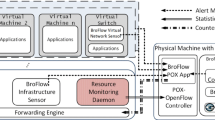Abstract
Our work proposes a generic architecture for runtime monitoring and optimization of IDS based on the challenge insertion. The challenges, known instances of malicious or legitimate behavior, are inserted into the network traffic represented by NetFlow records, processed with the current traffic and the system’s response to the challenges is used to determine its effectiveness and to fine-tune its parameters. The insertion of challenges is based on the threat models expressed as attack trees with attached risk/loss values. The use of threat model allows the system to measure the expected undetected loss and to improve its performance with respect to the relevant threats, as we have verified in the experiments performed on live network traffic.
Preview
Unable to display preview. Download preview PDF.
Similar content being viewed by others
References
Denning, D.E.: An intrusion-detection model. IEEE Trans. Softw. Eng. 13, 222–232 (1987)
Staab, E., Fusenig, V., Engel, T.: Towards trust-based acquisition of unverifiable information. In: Klusch, M., Pěchouček, M., Polleres, A. (eds.) CIA 2008. LNCS (LNAI), vol. 5180, pp. 41–54. Springer, Heidelberg (2008)
Rehák, M., Pechoucek, M., Grill, M., Bartos, K.: Trust-based classifier combination for network anomaly detection. In: Klusch, M., Pěchouček, M., Polleres, A. (eds.) CIA 2008. LNCS (LNAI), vol. 5180, pp. 116–130. Springer, Heidelberg (2008)
Rehák, M., Pechoucek, M., Bartos, K., Grill, M., Celeda, P., Krmicek, V.: Improving anomaly detection error rate by collective trust modeling. In: Lippmann, R., Kirda, E., Trachtenberg, A. (eds.) RAID 2008. LNCS, vol. 5230, pp. 398–399. Springer, Heidelberg (2008)
Cisco Systems: Cisco IOS NetFlow (2007), http://www.cisco.com/go/netflow
Scarfone, K., Mell, P.: Guide to intrusion detection and prevention systems (idps). Technical Report 800-94, NIST, US Dept. of Commerce (2007)
Xu, K., Zhang, Z.L., Bhattacharrya, S.: Reducing Unwanted Traffic in a Backbone Network. In: USENIX Workshop on Steps to Reduce Unwanted Traffic in the Internet (SRUTI), Boston, MA (2005)
Lakhina, A., Crovella, M., Diot, C.: Mining Anomalies using Traffic Feature Distributions. In: ACM SIGCOMM, Philadelphia, PA, pp. 217–228. ACM Press, New York (2005)
Lakhina, A., Crovella, M., Diot, C.: Diagnosis Network-Wide Traffic Anomalies. In: ACM SIGCOMM 2004, pp. 219–230. ACM Press, New York (2004)
Ertoz, L., Eilertson, E., Lazarevic, A., Tan, P.N., Kumar, V., Srivastava, J., Dokas, P.: Minds - minnesota intrusion detection system. In: Next Generation Data Mining. MIT Press, Cambridge (2004)
Sridharan, A., Ye, T., Bhattacharyya, S.: Connectionless port scan detection on the backbone, Phoenix, AZ, USA (2006)
Yager, R.: On ordered weighted averaging aggregation operators in multicriteria decision making. IEEE Transactions on Systems, Man, and Cybernetics 18, 183–190 (1988)
Rubinstein, B.I.P., Nelson, B., Huang, L., Joseph, A.D., Lau, S.-h., Taft, N., Tygar, J.D.: Evading anomaly detection through variance injection attacks on PCA. In: Lippmann, R., Kirda, E., Trachtenberg, A. (eds.) RAID 2008. LNCS, vol. 5230, pp. 394–395. Springer, Heidelberg (2008)
Moore, A.P., Ellison, R.J., Linger, R.C.: Attack modeling for information security and survivability. Technical Report CMU/SEI-2001-TN-001, CMU Software Engineering Institute (2001)
Quine, W.: A way to simplify truth functions. American Mathematical Monthly 62, 627–631 (1955)
Moore, D.S.: The Basic Practice of Statistics, 4th edn. W. H. Freeman & Co., New York (2007)
Polikar, R.: Esemble based systems in decision making. IEEE Circuits and Systems Mag. 6, 21–45 (2006)
Sheyner, O., Haines, J., Jha, S., Lippmann, R., Wing, J.M.: Automated generation and analysis of attack graphs. In: SP 2002: Proceedings of the 2002 IEEE Symposium on Security and Privacy, Washington, DC, USA, p. 273. IEEE Computer Society, Los Alamitos (2002)
Zhang, Y., Fan, X., Wang, Y., Xue, Z.: Attack grammar: A new approach to modeling and analyzing network attack sequences. In: Proc. of the Annual Computer Security Applications Conference (ACSAC 2008), pp. 215–224 (2008)
Sarmenta, L.F.G.: Sabotage-tolerance mechanisms for volunteer computing systems. In: CCGRID 2001: Proc. of the 1st Int. Symposium on Cluster Computing and the Grid, Washington, DC, USA, p. 337. IEEE Computer Society, Los Alamitos (2001)
Zhao, S., Lo, V., GauthierDickey, C.: Result verification and trust-based scheduling in peerto- peer grids. In: P2P 2005: Proc. of the 5th IEEE Int. Conf. on Peer-to-Peer Computing, Washington, DC, USA, pp. 31–38. IEEE Computer Society, Los Alamitos (2005)
Giacinto, G., Perdisci, R., Rio, M.D., Roli, F.: Intrusion detection in computer networks by a modular ensemble of one-class classifiers. Information Fusion 9, 69–82 (2008)
Ghanbari, S., Amza, C.: Semantic-driven model composition for accurate anomaly diagnosis. In: ICAC 2008: Proceedings of the 2008 International Conference on Autonomic Computing, Washington, DC, USA, pp. 35–44. IEEE Computer Society, Los Alamitos (2008)
Dietterich, T.G.: Ensemble methods in machine learning. In: Kittler, J., Roli, F. (eds.) MCS 2000. LNCS, vol. 1857, pp. 1–15. Springer, Heidelberg (2000)
Morin, B., Mé, L., Debar, H., Ducassé, M.: M2D2: A formal data model for IDS alert correlation. In: Wespi, A., Vigna, G., Deri, L. (eds.) RAID 2002. LNCS, vol. 2516, pp. 115–137. Springer, Heidelberg (2002)
Author information
Authors and Affiliations
Editor information
Editors and Affiliations
Rights and permissions
Copyright information
© 2009 Springer-Verlag Berlin Heidelberg
About this paper
Cite this paper
Rehák, M. et al. (2009). Runtime Monitoring and Dynamic Reconfiguration for Intrusion Detection Systems. In: Kirda, E., Jha, S., Balzarotti, D. (eds) Recent Advances in Intrusion Detection. RAID 2009. Lecture Notes in Computer Science, vol 5758. Springer, Berlin, Heidelberg. https://doi.org/10.1007/978-3-642-04342-0_4
Download citation
DOI: https://doi.org/10.1007/978-3-642-04342-0_4
Publisher Name: Springer, Berlin, Heidelberg
Print ISBN: 978-3-642-04341-3
Online ISBN: 978-3-642-04342-0
eBook Packages: Computer ScienceComputer Science (R0)




